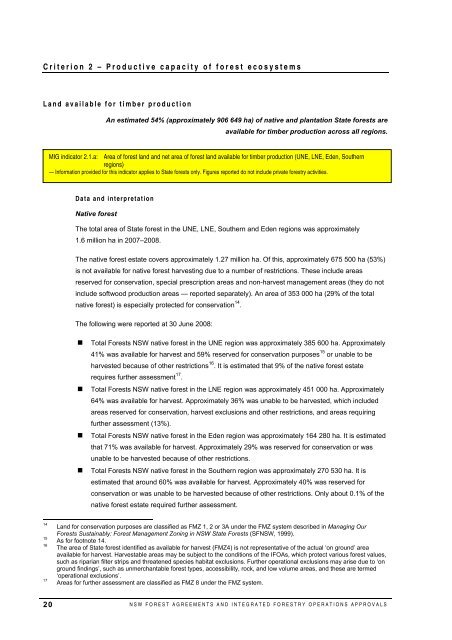Progress Report 2007-2008 - Department of Environment and ...
Progress Report 2007-2008 - Department of Environment and ...
Progress Report 2007-2008 - Department of Environment and ...
You also want an ePaper? Increase the reach of your titles
YUMPU automatically turns print PDFs into web optimized ePapers that Google loves.
Criterion 2 – Productive capacity <strong>of</strong> forest ecosystems<br />
L<strong>and</strong> available for timber production<br />
20<br />
An estimated 54% (approximately 906 649 ha) <strong>of</strong> native <strong>and</strong> plantation State forests are<br />
Data <strong>and</strong> interpretation<br />
Native forest<br />
available for timber production across all regions.<br />
MIG indicator 2.1.a: Area <strong>of</strong> forest l<strong>and</strong> <strong>and</strong> net area <strong>of</strong> forest l<strong>and</strong> available for timber production (UNE, LNE, Eden, Southern<br />
regions)<br />
— Information provided for this indicator applies to State forests only. Figures reported do not include private forestry activities.<br />
The total area <strong>of</strong> State forest in the UNE, LNE, Southern <strong>and</strong> Eden regions was approximately<br />
1.6 million ha in <strong>2007</strong>–<strong>2008</strong>.<br />
The native forest estate covers approximately 1.27 million ha. Of this, approximately 675 500 ha (53%)<br />
is not available for native forest harvesting due to a number <strong>of</strong> restrictions. These include areas<br />
reserved for conservation, special prescription areas <strong>and</strong> non-harvest management areas (they do not<br />
include s<strong>of</strong>twood production areas — reported separately). An area <strong>of</strong> 353 000 ha (29% <strong>of</strong> the total<br />
native forest) is especially protected for conservation 14 .<br />
The following were reported at 30 June <strong>2008</strong>:<br />
Total Forests NSW native forest in the UNE region was approximately 385 600 ha. Approximately<br />
41% was available for harvest <strong>and</strong> 59% reserved for conservation purposes 15 or unable to be<br />
harvested because <strong>of</strong> other restrictions 16 . It is estimated that 9% <strong>of</strong> the native forest estate<br />
requires further assessment 17 .<br />
Total Forests NSW native forest in the LNE region was approximately 451 000 ha. Approximately<br />
64% was available for harvest. Approximately 36% was unable to be harvested, which included<br />
areas reserved for conservation, harvest exclusions <strong>and</strong> other restrictions, <strong>and</strong> areas requiring<br />
further assessment (13%).<br />
Total Forests NSW native forest in the Eden region was approximately 164 280 ha. It is estimated<br />
that 71% was available for harvest. Approximately 29% was reserved for conservation or was<br />
unable to be harvested because <strong>of</strong> other restrictions.<br />
Total Forests NSW native forest in the Southern region was approximately 270 530 ha. It is<br />
estimated that around 60% was available for harvest. Approximately 40% was reserved for<br />
conservation or was unable to be harvested because <strong>of</strong> other restrictions. Only about 0.1% <strong>of</strong> the<br />
native forest estate required further assessment.<br />
14 L<strong>and</strong> for conservation purposes are classified as FMZ 1, 2 or 3A under the FMZ system described in Managing Our<br />
Forests Sustainably: Forest Management Zoning in NSW State Forests (SFNSW, 1999).<br />
15 As for footnote 14.<br />
16 The area <strong>of</strong> State forest identified as available for harvest (FMZ4) is not representative <strong>of</strong> the actual ‘on ground’ area<br />
available for harvest. Harvestable areas may be subject to the conditions <strong>of</strong> the IFOAs, which protect various forest values,<br />
such as riparian filter strips <strong>and</strong> threatened species habitat exclusions. Further operational exclusions may arise due to ‘on<br />
ground findings’, such as unmerchantable forest types, accessibility, rock, <strong>and</strong> low volume areas, <strong>and</strong> these are termed<br />
‘operational exclusions’.<br />
17 Areas for further assessment are classified as FMZ 8 under the FMZ system.<br />
NSW FOREST AGREEMENTS AND INTEGRATED FORESTRY OPERATIONS APPROVALS

















